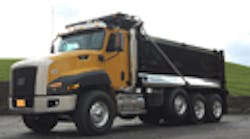EDWARDS, IL. With shipments to customers already underway and production expected to be fully ramped up by October’s end, Caterpillar is placing a big bet on the back of its new CT660 vocational truck – expecting it to make Caterpillar one of the dominant, if not the dominant, truck maker in the vocational market by 2016.
“We expect within five years to be the number-one or number-two player in the vocational market due to this truck,” said George Taylor, director of Caterpillar’s global on-highway truck group, during a special ride and drive event held here at the company’s Edwards Demonstration & Learning Center.
(Video: A look at the CT660)
“We think we have an exciting [truck] package here and are one of the only suppliers to offer a completely integrated engine and fully automatic transmission in this market,” he added. “But our focus is not just on offering a new truck. The focus rather is on optimizing how the truck works within specific applications so it can help customers make more money.”
(To learn about the history of the Cat CT660, read "A long, winding trail for the CT660")
Caterpillar is having the CT660 built in Garland, TX, via a partnership with Navistar, with the CT660’s “bones” based on Navistar’s PayStar chassis. However, Gary Blood, Cat vocational truck product manager, stressed that “from the frame rails up, there’s very little commonality between the CT660 and the PayStar,” especially when it comes to the cab, engine, transmission, and certain suspension components.
(Video: A look at the CT660 from the inside)
“We even have different pinion arms and linkages within the steering systems; that’s how different these trucks are,” Blood added.
He noted that Caterpillar began shipping the first CT660 units to roll off the Garland production line this month to customers and that they are being equipped with either a 10.5L C11 diesel engine – producing between 330 and 390 hp. and 1,250 to 1,450 lbs.-ft. or torque – or a 12.4L C13 diesel, which cranks out 410 to 475 hp. and 1,450 to 1,700 lbs.-ft. or torque.
(Photos: New looks at the CT660)
Buyers can currently spec either an Eaton Fuller 8LL 8-spd. manual transmission or Caterpillar’s proprietary CX31 automatic transmission for the CT660, though Blood noted Eaton’s Ultrashift automated mechanical transmission (AMT) should become an option by the end of October.
The company also expects to offer a factory-installed lift axle for the CT660 by the end of the fourth quarter, as well as a Telma retarder for its automatic transmission to help increase fuel economy.
(See more photos of the CT660)
By the first quarter of next year, he said Caterpillar expects to add another engine option to the CT660; a C15 block offering 450 to 550 hp. and 1,550 to 1,850 lbs.-ft. of torque. The C15 will also come with a free” flash file” so customers that initially spec a 450 hp. rating can upgrade it 550 hp. to boost resale value. “The cooling system and transmissions are already set to handle those higher ratings,” he explained.
By the first quarter of 2013, Blood said Caterpillar expects to roll out a set forward axle configuration for its vocational truck, dubbed the CT680, which can be spec’d with any of its three engine blocks, its CX31 automatic, as well as Eaton’s manual or AMT. “We also expect to offer a factory-built twin steer model for the Canadian vocational market,” he added. “But as the [bridge] formulas vary from province to province, we still need to work out the details.”
Blood also isn’t worried about whether Navistar’s Garland plant – which also builds the PayStar, WorkStar, TranStar, military trucks, and some ProStar highway tractors – has enough capacity to handle any type of surge in orders for the CT660.
“Right now the plant is working one shift four days a week,” he explained. “It has the capacity to ramp up to two shifts working five days a week. So we’re comfortable that we have plenty of available [production] capacity to meet demand.”
Taylor noted that other options and upgraded features are also in the works for the CT660 and future CT680 models in order to make them more functional and profitable tools for customers. For example, through Caterpillar’s proprietary “Product Link” fleet monitoring and control service, the potential exists to integrate trucks with other work site machines such as pavers or front-end loaders to help boost productivity at the job site.
“Imagine if a paving machine operator could control the dump bed of the truck through the Product Link system incorporated into them in order to better control milling and paving operations,” Taylor explained. “That could end up providing real productivity benefits to contractor companies.”
That’s why he noted that the “real magic” for vocational trucks in the near future isn’t just about understanding what the customer wants today, but creating something the customer didn’t know he or she needed – but can’t live without once they get their hands on it.
“That goes beyond merely building a new truck to creating a vehicle that can leverage telematics and operating characteristics to generate strategic competitive advantages for customers,” he said.



